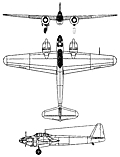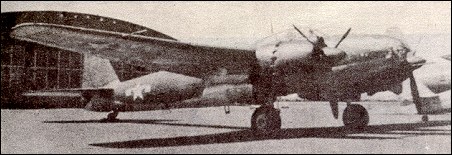|
| Requiring a fast medium bomber for dive-bombing, low-altitude bombing or torpedo attack, the Imperial Japanese Navy instructed the Yokosuka First Naval Air Technical Arsenal in 1940 to begin design of such an aircraft. The resulting Yokosuka P1Y prototype flown in August 1943 was a mid-wing, all-metal monoplane, powered by two Nakajima NK9B Homare 11 radial engines. Its performance was satisfactory, but the P1Y suffered from maintenance problems that plagued its service life. All remedial attempts failed, delaying until early 1945 the entry into service of the Navy Bomber Ginga Model 11. Production totalled 1098, built by Kawanishi (96) and Nakajima (1002), and if there had been adequate manpower to service these aircraft before each operational sortie they would have proved formidable adversaries. This was not possible and as a result the Ginga (Milky Way), allocated the Allied codename 'Francis', was
tried unsuccessfully in a variety of alternative roles; its brief operational life of only six months was terminated by the end of the Pacific war.

| MODEL | P1Y1 |
| CREW | 3 |
| ENGINE | 2 x Nakajima "Homare-21", 1370kW |
| WEIGHTS |
| Take-off weight | 10500 kg | 23149 lb |
| Empty weight | 7265 kg | 16017 lb |
| DIMENSIONS |
| Wingspan | 20.0 m | 66 ft 7 in |
| Length | 15.0 m | 49 ft 3 in |
| Height | 4.3 m | 14 ft 1 in |
| Wing area | 55.0 m2 | 592.01 sq ft |
| PERFORMANCE |
| Max. speed | 550 km/h | 342 mph |
| Cruise speed | 380 km/h | 236 mph |
| Ceiling | 9400 m | 30850 ft |
| Range w/max.fuel | 4650 km | 2889 miles |
| Range w/max payload | 1900 km | 1181 miles |
| ARMAMENT | 2 x 20mm cannons, 1000kg of bombs |
 | A three-view drawing (752 x 985) |
| Barry, 20.06.2012 18:08 Fitted out as a night fighter the Ginga featured a 20mm nose cannon and two canted upward firing 20mm cannon similar to the German "Shrage Musik" system. However, the whole programme was plagued by poor matainence and poorly trained recruits and so any success that may have been aspired to was only transitory. By the time it showed up the USAAF was bombing the homeland to a pulp and the USN, through it's submarine force, had laid siege to Japan that raw materials were becoming more and more difficult to come by.
One last comment the Frances was "the successor to the Betty", are you sure? reply | | David Stubblebine, e-mail, 08.08.2011 02:55 This page identifies the Allied Code Name for the P1Y Ginga as "Francis." This is, of course, incorrect. Allied Code names used men's names for fighters and women's names for bombers so the correct code name for the P1Y was the "Frances." reply | | paidui, 20.06.2011 06:41 I read an account by a youngster fresh from Bomber School being converted onto Gingas...couldn't believe his luck!! Flew straight to his mum's house for a fly over! He survived the war to have bragging rights about his time on Gingas! reply | | DebtMan, e-mail, 01.10.2010 07:18 The Ginga was the successor of the Betty.Despite of that,the Betty was more frequent used and the Ginga was only limited use.Was operated as torpedo-bomber and mid-bomber.In 1944-mid,few Gingas was converted in night fighters,but was so few effective and due to that,was new converted in bombers.In the closing stages of the war,the Ginga was used as kamikaze and launcher of MXY7 reply | |
| | Mike Dunne, e-mail, 18.03.2010 07:54 What a fabulous bit of kit this bomber was! Imagine young sprog pilots being posted to fly them! Bugger the consequences...just let me fly the thing!
I read an account by a youngster fresh from Bomber School being converted onto Gingas...couldn't believe his luck!! Flew straight to his mum's house for a fly over! He survived the war to have bragging rights about his time on Gingas! reply |
|
Do you have any comments?
|
| 
COMPANY
PROFILE
All the World's Rotorcraft
|








